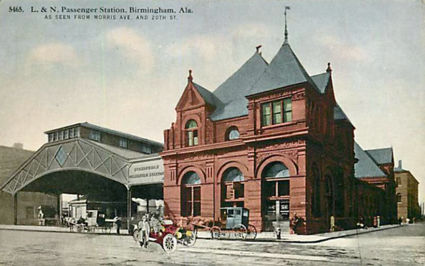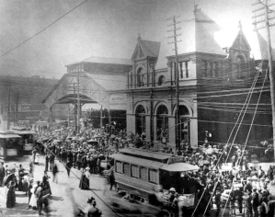Union Station: Difference between revisions
m (→1960 station) |
Realkyhick (talk | contribs) m (correct Amtrak spelling) |
||
| (8 intermediate revisions by 2 users not shown) | |||
| Line 1: | Line 1: | ||
[[Image:L&N | [[Image:L&N Station postcard.jpg|right|thumb|425px|Postcard view of the L&N Station]] | ||
The ''' | The '''Union Passenger Station''' or '''Birmingham Passenger Station''', also called the '''L. & N. Station''', or even the '''"Ellen N" Depot''', was the first true passenger rail station in [[Birmingham]], taking the place of a series of wood-framed shelters over the passenger platforms that preceded it. The station was constructed by the [[Louisville & Nashville Railroad]] on the former site of the [[Relay House]] hotel, whose verandas had served as a substitute waiting room. Construction cost $134,163. | ||
Originally the station served not only the L&N Railroad, but also the [[Alabama Great Southern Railroad]] and the [[Georgia-Pacific Railway]]. It opened on [[April 1]], [[1887]] and [[Engine No. 95]], under the control of [[W. L. Rosser]] was the first locomotive to pull in. Station master [[C. E. Meglemry]] initially oversaw the arrival and departure of eighteen trains each day. | |||
A two-story brick addition was made to the depot in [[1900]] or [[1901]]. The first arrival from the [[Atlanta, Birmingham & Atlantic Railway]] was celebrated on [[September 8]], [[1908]] just as the new [[Terminal Station]] was nearing completion. Over the years the Union Depot also served the [[Birmingham Mineral Railroad]], the [[Southern Railway]], the [[Kansas City, Memphis & Birmingham Railroad]], and the [[Central of Georgia Railway]]. | |||
All passenger service except for the L&N and AB&A trains moved to the [[Birmingham Terminal Station]] in [[1909]], leaving the Union Station to become known as the L&N Station. | |||
[[Image:L&N station 1898.jpg|left|thumb|275px|Soldiers await deployment at the L&N Station on May 1, 1898]] | |||
The station's large train shed, spanning over several tracks at grade level, was dismantled in the early 1930's to accommodate Birmingham's downtown [[grade separation]] project. By raising the trackage above grade level, an [[20th Street underpass|underpass]] could be constructed at [[20th Street North]], eliminating a dangerous grade crossing on Birmingham's main street. Around the same time the [[Atlanta, Birmingham & Coast Railroad]] moved its passenger service to [[Elyton Yard]] in [[West End]], leaving L&N as the station's sole occupant. | |||
The | The L&N Station, past its prime and serving only a fraction of the passenger traffic it once hosted, was relocated in [[1960]] to a new, [[L & N Station (1960)|smaller facility]] at 1819-1825 [[Morris Avenue]], just west in advance of the construction of the [[1962]] [[Bank for Savings Building]]. The move allowed for [[19th Street underpass|another underpass]] to be constructed at [[19th Street North|19th Street]]. The new station was eventually given over to [[Amtrak]] passenger service and became known as the [[Birmingham Amtrak Station]]. | ||
==References== | ==References== | ||
* Berman, Irving (June 22, 1959) "[http://www.birminghamrewound.com/features/LN-1(6-59).jpg Skyscraper to replace L&N railroad station]" | * "Birmingham Welcomes Another Railroad" (September 7, 1908) {{BN}} | ||
* Kincey, Bob (July 19, 1960) editorial column. | * Berman, Irving (June 22, 1959) "[http://www.birminghamrewound.com/features/LN-1(6-59).jpg Skyscraper to replace L&N railroad station]" {{BN}} | ||
* Kincey, Bob (July 19, 1960) editorial column. {{BN}} | |||
* Key, Lyle. "Union Station/L&N Station" in Marvin Clemons and Lyle Key (2007) ''Birmingham Rails: The Last Golden Era from World War II to Amtrak''. Birmingham: Red Mountain Press. ISBN 9780615143538 | * Key, Lyle. "Union Station/L&N Station" in Marvin Clemons and Lyle Key (2007) ''Birmingham Rails: The Last Golden Era from World War II to Amtrak''. Birmingham: Red Mountain Press. ISBN 9780615143538 | ||
[[Category:1887 buildings]] | [[Category:1887 buildings]] | ||
[[Category:1960 | [[Category:1960 demolitions]] | ||
[[Category:Railroad stations]] | [[Category:Railroad stations]] | ||
[[Category:Railroad Reservation]] | [[Category:Railroad Reservation]] | ||
Latest revision as of 21:11, 13 October 2019
The Union Passenger Station or Birmingham Passenger Station, also called the L. & N. Station, or even the "Ellen N" Depot, was the first true passenger rail station in Birmingham, taking the place of a series of wood-framed shelters over the passenger platforms that preceded it. The station was constructed by the Louisville & Nashville Railroad on the former site of the Relay House hotel, whose verandas had served as a substitute waiting room. Construction cost $134,163.
Originally the station served not only the L&N Railroad, but also the Alabama Great Southern Railroad and the Georgia-Pacific Railway. It opened on April 1, 1887 and Engine No. 95, under the control of W. L. Rosser was the first locomotive to pull in. Station master C. E. Meglemry initially oversaw the arrival and departure of eighteen trains each day.
A two-story brick addition was made to the depot in 1900 or 1901. The first arrival from the Atlanta, Birmingham & Atlantic Railway was celebrated on September 8, 1908 just as the new Terminal Station was nearing completion. Over the years the Union Depot also served the Birmingham Mineral Railroad, the Southern Railway, the Kansas City, Memphis & Birmingham Railroad, and the Central of Georgia Railway.
All passenger service except for the L&N and AB&A trains moved to the Birmingham Terminal Station in 1909, leaving the Union Station to become known as the L&N Station.
The station's large train shed, spanning over several tracks at grade level, was dismantled in the early 1930's to accommodate Birmingham's downtown grade separation project. By raising the trackage above grade level, an underpass could be constructed at 20th Street North, eliminating a dangerous grade crossing on Birmingham's main street. Around the same time the Atlanta, Birmingham & Coast Railroad moved its passenger service to Elyton Yard in West End, leaving L&N as the station's sole occupant.
The L&N Station, past its prime and serving only a fraction of the passenger traffic it once hosted, was relocated in 1960 to a new, smaller facility at 1819-1825 Morris Avenue, just west in advance of the construction of the 1962 Bank for Savings Building. The move allowed for another underpass to be constructed at 19th Street. The new station was eventually given over to Amtrak passenger service and became known as the Birmingham Amtrak Station.
References
- "Birmingham Welcomes Another Railroad" (September 7, 1908) The Birmingham News
- Berman, Irving (June 22, 1959) "Skyscraper to replace L&N railroad station" The Birmingham News
- Kincey, Bob (July 19, 1960) editorial column. The Birmingham News
- Key, Lyle. "Union Station/L&N Station" in Marvin Clemons and Lyle Key (2007) Birmingham Rails: The Last Golden Era from World War II to Amtrak. Birmingham: Red Mountain Press. ISBN 9780615143538

